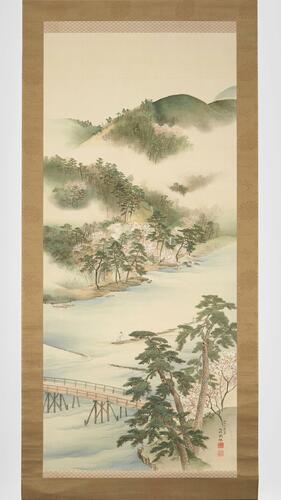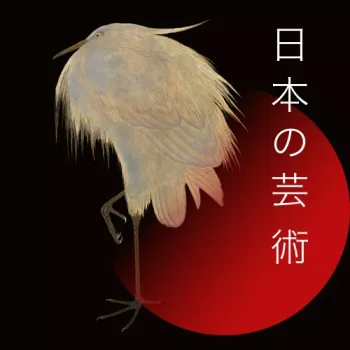Hanging scroll painting (kakemono) 1922
Ink and colour on paper, silk brocade, bone, wood | 276.5 x 86.7 cm (whole object) | RCIN 69750
-
Kakemono are hanging scrolls displayed in the dedicated alcove (tokonoma) of a reception room. Unlike painted sliding and folding screens, this form did not become popular in Japan until the late Kamakura period (1185–1333), with the exception of memorial paintings in Buddhist temples and Shintō shrines. The import of hanging scrolls from China in the early fourteenth century prompted the reconfiguration of indoor spaces to accommodate their display. Kakemono soon became an essential component of a wealthy samurai residence. In the Edo period, prints in this format (kakemono-e) provided a more modest alternative for artisans who could not afford painted examples.
Seasonal landscapes were a popular subject for kakemono. Here, the pine-clad mountain, Arashiyama, near Kyoto, emerges from the mist. Diagonal lines of trees draw the viewer’s eye down the length of the scroll to men punting rafts of timber down the Katsura River by the Togetsukyō Bridge. Cherry blossom indicates that it is springtime, and the season’s freshness is reinforced by the bright mounting of gold and green brocade.
The painting is the work of Mitsui Takamine, an amateur artist and the tenth head of the Mitsui Sōryō family, who managed a conglomerate of trading, banking and mining companies. A devoted aesthete, Mitsui was a practitioner of the tea ceremony and of Nō drama. For the visit to Japan of Edward, Prince of Wales in 1922, he erected a theatre in the courtyard of his mansion at a reported cost of £30,000. After the visit, he presented the prince with this kakemono. The composition is redolent of a scene by the Edo-period woodblock print artist, Utagawa Hiroshige I.
Text adapted from Japan: Courts and Culture (2020)Provenance
Presented to King Edward VIII when Prince of Wales by Mitsui Takamine in Japan, 1922. ('List of letters of thanks sent to donors in Japan', RA/EVIIIPWH/PS/VISOV/1921-2/INDJAP).
Loaned to The British Museum in 1939. -
Creator(s)
(nationality)Acquirer(s)
-
Medium and techniques
Ink and colour on paper, silk brocade, bone, wood
Measurements
276.5 x 86.7 cm (whole object)
160.4 x 70.9 cm (image)
11.0 x 99.0 x 13.0 cm (whole object)
Object type(s)










